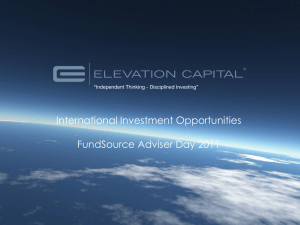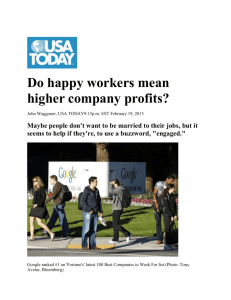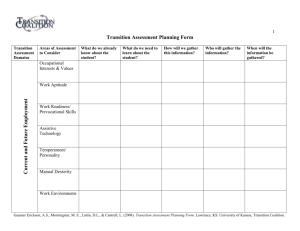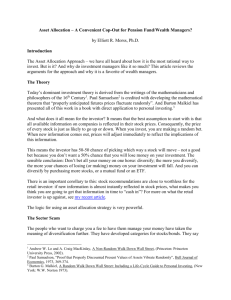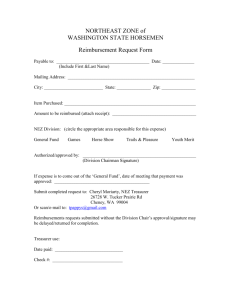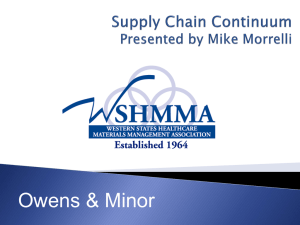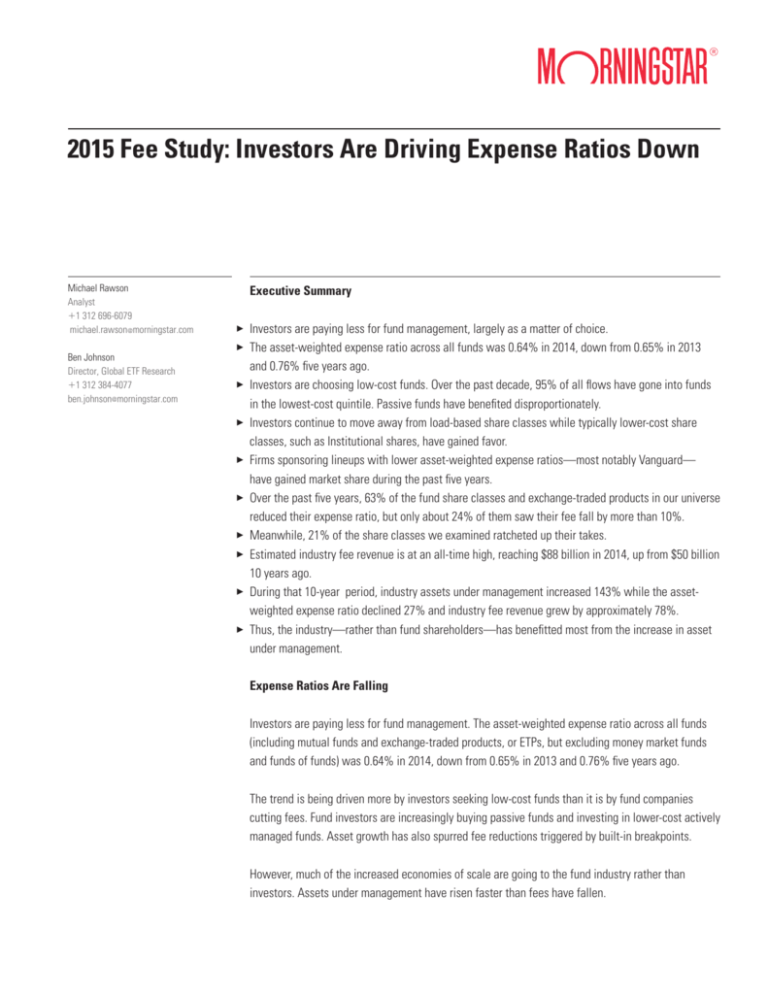
2015 Fee Study: Investors Are Driving Expense Ratios Down
Michael Rawson
Analyst
+1 312 696-6079
michael.rawson@morningstar.com
Ben Johnson
Director, Global ETF Research
+1 312 384-4077
ben.johnson@morningstar.com
Executive Summary
3 Investors are paying less for fund management, largely as a matter of choice.
3 The asset-weighted expense ratio across all funds was 0.64% in 2014, down from 0.65% in 2013
and 0.76% five years ago.
3 Investors are choosing low-cost funds. Over the past decade, 95% of all flows have gone into funds
in the lowest-cost quintile. Passive funds have benefited disproportionately.
3 Investors continue to move away from load-based share classes while typically lower-cost share
classes, such as Institutional shares, have gained favor.
3 Firms sponsoring lineups with lower asset-weighted expense ratios—most notably Vanguard—
have gained market share during the past five years.
3 Over the past five years, 63% of the fund share classes and exchange-traded products in our universe
reduced their expense ratio, but only about 24% of them saw their fee fall by more than 10%.
3 Meanwhile, 21% of the share classes we examined ratcheted up their takes.
3 Estimated industry fee revenue is at an all-time high, reaching $88 billion in 2014, up from $50 billion
10 years ago.
3 During that 10-year period, industry assets under management increased 143% while the assetweighted expense ratio declined 27% and industry fee revenue grew by approximately 78%.
3 Thus, the industry—rather than fund shareholders—has benefitted most from the increase in asset
under management.
Expense Ratios Are Falling
Investors are paying less for fund management. The asset-weighted expense ratio across all funds
(including mutual funds and exchange-traded products, or ETPs, but excluding money market funds
and funds of funds) was 0.64% in 2014, down from 0.65% in 2013 and 0.76% five years ago.
The trend is being driven more by investors seeking low-cost funds than it is by fund companies
cutting fees. Fund investors are increasingly buying passive funds and investing in lower-cost actively
managed funds. Asset growth has also spurred fee reductions triggered by built-in breakpoints.
However, much of the increased economies of scale are going to the fund industry rather than
investors. Assets under management have risen faster than fees have fallen.
Page 2 of 11
2015 Fee Study: Investors Are Driving Expense Ratios Down
3 A Look at the Numbers: Asset-Weighted vs. Equal-Weighted
3
3 We emphasize the asset-weighted expense ratio rather than a straight average as it is more
representative of the actual costs borne by investors than a straight average. Equal-weighted
averages tend to be skewed by a few outliers—high-cost funds that attract few assets, in this case.
The equal-weighted average expense ratio for all funds in 2014 was 1.19%, but funds with
an expense ratio above that level held just 9% of total assets at the end of 2014. Some 91% of
investors’ assets were invested in funds with an expense ratio less than or equal to 1.19%. Thus, the
equal-weighted average expense ratio is a bit of a straw man. The asset-weighted expense ratio,
which best reflects investors’ collective experience, was 0.64% in 2014.
Exhibit 1 Asset-Weighted Expense Ratios
Active
Passive
All Funds
1.20
%
1.00
0.80
0.60
0.40
0.20
1990
1994
1998
2002
2006
2010
Source: Morningstar, Inc.
Investors Are Choosing Low-Cost Funds
During the past decade, low-cost funds have been attracting far more inflows than their moreexpensive peers. This has helped to reduce the industry’s average asset-weighted expense ratio over
time. Mutual funds and ETPs with expense ratios ranking in the least-expensive quintile of all funds
attracted an aggregate $3.03 trillion of estimated net inflows during the past 10 years, compared
with just $160 billion for funds in the remaining four quintiles. That is to say that 95% of all flows
have gone into funds in the lowest-cost quintile. Passive funds (mutual funds and ETPs) have been
©2015 Morningstar. All rights reserved. The information, data, analyses, and opinions contained herein (1) are proprietary to Morningstar, Inc. and its affiliates (collectively, “Morningstar”), (2) may not be copied or
redistributed, (3) do not constitute investment advice offered by Morningstar (4) are provided solely for informational purposes and therefore are not an offer to buy or sell a security, and (5) are not warranted
to be accurate, complete, or timely. Morningstar shall not be responsible for any trading decisions, damages, or other losses resulting from, or related to, this information, data, analyses or opinions or their use.
Past performance is no guarantee of future results.
Page 3 of 11
2015 Fee Study: Investors Are Driving Expense Ratios Down
prominent recipients of the capital flowing into low-cost funds. Compared with funds falling in cost
quintiles 2 through 5, funds in the lowest-cost quintile are more likely to be index funds.
The asset-weighted expense ratio for passive funds was just 0.20% in 2014, compared with 0.79%
for active funds. Estimated net inflows to passive funds in 2014 totaled $392 billion, topping the $66
billion of flows into active funds. During the past 10 years, passive funds have collected $1.90 trillion
in net new investor capital compared with $1.13 trillion for active funds. The difference is even
starker among U.S. equity funds. Passive funds focused on U.S. stocks have attracted $671 billion of
inflows during the past 10 years, compared with outflows of $731 billion for active U.S. equity funds.
Passive funds now account for 28% of the total assets in the universe we’ve examined, up from 13%
in 2004. But this preference for lower-cost fare isn’t limited to the realm of passive funds. Even
within active funds, the lowest-cost quintile received $1.07 trillion of the $1.13 trillion of estimated
net new flows during the past decade.
Exhibit 2 Estimated Net Flows by Expense Ratio Quintile $ Billion
Lowest-Cost Quintile
Quintiles 2 Through 5
600
$ Bil
400
200
0
2005
2006
2007
2008
2009
2010
2011
2012
Source: Morningstar, Inc.
©2015 Morningstar. All rights reserved. The information, data, analyses, and opinions contained herein (1) are proprietary to Morningstar, Inc. and its affiliates (collectively, “Morningstar”), (2) may not be copied or
redistributed, (3) do not constitute investment advice offered by Morningstar (4) are provided solely for informational purposes and therefore are not an offer to buy or sell a security, and (5) are not warranted
to be accurate, complete, or timely. Morningstar shall not be responsible for any trading decisions, damages, or other losses resulting from, or related to, this information, data, analyses or opinions or their use.
Past performance is no guarantee of future results.
2013
2014
Page 4 of 11
2015 Fee Study: Investors Are Driving Expense Ratios Down
3
3 Exhibit 3 below shows the aggregate effect of this trend over the course of the past decade. In 2004,
3 about 20% of investors’ assets were invested in funds with expense ratios less than or equal to
0.50%. By 2014, 41% of investors’ assets were invested in funds with expense ratios at or below
this threshold. Investors are expressing a clear preference for low-cost funds.
Exhibit 3 Distribution of Fund Assets by Expense Ratio
2004
2009
2014
100
%
80
60
40
20
0
0.5
1.0
1.5
2.0
2.5
>3.0
Source: Morningstar, Inc.
Share-Class Warfare
In addition to migrating en masse to lower-cost funds, investors also are flocking toward lower-cost
share classes. Investors continue to move away from load-based share classes while typically
lower-cost share classes, such as Institutional shares, have gained favor.
This trend has been driven by a number of factors. For instance, advisors are increasingly using
wrap or omnibus accounts that bundle individual accounts in a manner that creates scale and gives
them access to Institutional share classes. Also, fee-based advisors are bypassing load shares and
opting to use exchange-traded funds or other no-load options on behalf of their clients. Advisors
using no-load funds for their clients typically change for their services outside the fund’s expense
©2015 Morningstar. All rights reserved. The information, data, analyses, and opinions contained herein (1) are proprietary to Morningstar, Inc. and its affiliates (collectively, “Morningstar”), (2) may not be copied or
redistributed, (3) do not constitute investment advice offered by Morningstar (4) are provided solely for informational purposes and therefore are not an offer to buy or sell a security, and (5) are not warranted
to be accurate, complete, or timely. Morningstar shall not be responsible for any trading decisions, damages, or other losses resulting from, or related to, this information, data, analyses or opinions or their use.
Past performance is no guarantee of future results.
Page 5 of 11
2015 Fee Study: Investors Are Driving Expense Ratios Down
3
3 ratio. Those additional fees are outside the scope of this study, which focuses only on fund expense
3 ratios. And finally, defined-contribution plans now make up a larger share of fund assets, driving
investor dollars toward Institutional and Retirement share classes.
In the exhibit below, we grouped fund shares into five categories: Other No-load, Institutional,
Load, ETPs, and Retirement. Load shares, which have by far the highest asset-weighted expense
ratio, have experienced a steep decline in market share in recent years. Load shares charged
an asset-weighted expense ratio of 1.02% in 2014 and held 20% of assets as of year-end, down
from 37% in 2004. During the past 10 years, load shares saw outflows of $0.5 trillion. This compares
with inflows of $3.5 trillion into all other mutual fund share classes and ETPs. The asset-weighted
expense ratio for all of these no-load share classes was just 0.54% in 2014.
Exhibit 4 Market Share of Fund Assets by Share Class Type
Other No-Load
Institutional
Load
ETPs
Retirement
50
%
40
30
20
10
2000
2002
2004
2006
2008
2010
2012
Source: Morningstar, Inc.
©2015 Morningstar. All rights reserved. The information, data, analyses, and opinions contained herein (1) are proprietary to Morningstar, Inc. and its affiliates (collectively, “Morningstar”), (2) may not be copied or
redistributed, (3) do not constitute investment advice offered by Morningstar (4) are provided solely for informational purposes and therefore are not an offer to buy or sell a security, and (5) are not warranted
to be accurate, complete, or timely. Morningstar shall not be responsible for any trading decisions, damages, or other losses resulting from, or related to, this information, data, analyses or opinions or their use.
Past performance is no guarantee of future results.
2014
Page 6 of 11
2015 Fee Study: Investors Are Driving Expense Ratios Down
3 Category Group
3
3 Asset-weighted expense ratios fell across each of the category groups we examined over the past
five years. However, those groups that tend to levy above-average fees such as international equity,
sector equity, and alternative increased their share of assets over that span. Funds that invest
primarily in U.S. equities saw their asset-weighted expense ratios fall to 0.58% from 0.74% while
their share of assets increased to 43% from 41%. It is no coincidence that the three category groups
that experienced the largest increase in the percentage of assets invested in passive funds were
also those that saw the largest declines in their asset-weighted expense ratios. It is also striking—
though not surprising—to see that funds in the alternative category are by far the most expensive,
charging (on an asset-weighted basis) more than twice the toll levied on the average investor dollar.
Exhibit 5 Asset-Weighted Expense Ratio, Market Share of Total Assets and Passive Share by Category Group
Asset Weighted Expense Ratio (%)
Market Share of Total Assets (%)
Passive Share (%)
2009
2014
Change
2009
2014
Change
2009
2014
Change
U.S. Equity
0.74
0.58
–0.17
40.6
43.2
2.7
25.7
36.9
11.2
Sector Equity
0.82
0.66
–0.15
3.9
5.2
1.3
34.1
45.7
11.6
International Equity
0.94
0.77
–0.17
17.2
16.0
–1.2
20.8
27.7
6.9
Allocation
0.84
0.77
–0.07
8.6
8.7
0.1
2.5
3.9
1.4
Alternative
1.24
1.31
0.07
1.2
1.4
0.2
45.9
22.5
–23.4
Taxable Bond
0.60
0.56
–0.04
21.2
20.9
–0.3
14.8
20.8
6.1
Municipal Bond
0.65
0.56
–0.09
6.1
4.2
–1.9
1.3
2.4
1.1
All Funds
0.76
0.64
–0.12
100
100
—
20.2
28.2
7.9
Source: Morningstar, Inc
Expense Ratio Trends by Firm
On average, firms sponsoring lineups with lower asset-weighted expense ratios gained market share
during the past five years. JPMorgan bucked this trend, experiencing a large increase in market share
despite the fact that its funds’ fees are not among the industry’s lowest. Vanguard had the largest
increase in market share among the top 10 fund families over the past five years. The firm also
has the lowest asset-weighted expense ratio among this group. Vanguard has widened its audience
in recent years. In particular it has appealed to the growing field of fee-based financial advisors who
might not have had an incentive to use Vanguard’s funds under a pay-for-distribution model.
©2015 Morningstar. All rights reserved. The information, data, analyses, and opinions contained herein (1) are proprietary to Morningstar, Inc. and its affiliates (collectively, “Morningstar”), (2) may not be copied or
redistributed, (3) do not constitute investment advice offered by Morningstar (4) are provided solely for informational purposes and therefore are not an offer to buy or sell a security, and (5) are not warranted
to be accurate, complete, or timely. Morningstar shall not be responsible for any trading decisions, damages, or other losses resulting from, or related to, this information, data, analyses or opinions or their use.
Past performance is no guarantee of future results.
Page 7 of 11
2015 Fee Study: Investors Are Driving Expense Ratios Down
3
3 and Market Share of Assets by Provider
Exhibit 6 Asset-Weighted Expense Ratio
3
Asset Weighted Expense Ratio (%)
Market Share of Total Assets (%)
Provider
2009
2014
Change
2009
2014
Change
Vanguard
0.20
0.14
–0.06
15.0
19.2
4.1
Fidelity Investments
0.76
0.59
–0.17
9.6
9.0
–0.5
American Funds
0.82
0.71
–0.10
11.8
8.4
–3.3
BlackRock/iShares
0.54
0.46
–0.09
6.2
7.0
0.8
Franklin Templeton Investments
0.95
0.87
–0.08
3.7
3.2
–0.5
T. Rowe Price
0.79
0.72
–0.07
2.8
3.3
0.5
SPDR State Street Global Advisors
0.21
0.17
–0.04
2.6
3.1
0.5
PIMCO
0.66
0.68
0.03
4.2
2.8
–1.4
JPMorgan
0.89
0.78
–0.11
1.2
1.9
0.7
Dimensional Fund Advisors
0.41
0.36
–0.05
1.3
1.7
0.4
Source: Morningstar, Inc
(Some) Fees Are Falling (Though Not by Much)
As we’ve outlined above, the fact that expense ratios, on average, are trending lower is not a
sign of a more generous approach to pricing by the industry. Nearly half of all funds have established
management fee breakpoints in their prospectuses, whereby expense ratios are automatically
reduced at pre-specified asset thresholds that are designed to pass economies of scale to
fundholders. As the current bull market has grown long in the horns, many funds have crossed
these thresholds because of some combination of asset-price appreciation and net new flows.
The asset-weighted expense ratio for all funds fell to 0.64% in 2014 from 0.76% in 2009, a decline
of 15%. However, during this span, just 63% of the fund share classes and ETPs that existed
in both 2009 and 2014 reduced their expense ratio, but and only about 24% of them saw their fee fall
by more than 10%. Meanwhile, 21% of the share classes we examined ratcheted up their take.
©2015 Morningstar. All rights reserved. The information, data, analyses, and opinions contained herein (1) are proprietary to Morningstar, Inc. and its affiliates (collectively, “Morningstar”), (2) may not be copied or
redistributed, (3) do not constitute investment advice offered by Morningstar (4) are provided solely for informational purposes and therefore are not an offer to buy or sell a security, and (5) are not warranted
to be accurate, complete, or timely. Morningstar shall not be responsible for any trading decisions, damages, or other losses resulting from, or related to, this information, data, analyses or opinions or their use.
Past performance is no guarantee of future results.
Page 8 of 11
2015 Fee Study: Investors Are Driving Expense Ratios Down
3
3 Exhibit 7 Distribution of Share Classes by Expense Ratio Change
3
Percentage Change in Annual Report Expense Ratio between 2009
and 2014
Percentage of Share Classes That
Existed in both 2009 and 2014
Decreased by more than 10%
24%
Decreased by up to 10%
39%
No Change
16%
Increased by up to 10%
14%
Increased by more than 10%
7%
Source: Morningstar, Inc
Fees by Type
While the annual report net expense ratio includes all explicit fees incurred by a fund, these fees can
be disaggregated and itemized according to their various sources, such as the advisor (management)
fees, administration fees, distribution fees, and so on. Not all firms break out these expenses nor are
they listed in a transparent and consistent way to help investment decision-makers.
Funds that held 84% of all assets as of the end of 2009 listed an advisor fee in both 2009 and 2014.
The asset-weighted advisor fee for these funds was 0.45% compared with an asset-weighted
net expense ratio of 0.79%. By 2014, the asset-weighted advisor fee had dropped by only 1 basis
point to 0.44% while the asset-weighted net expense ratio dropped to 0.67%. So the decline
in the asset-weighted net expense ratio we detail above was not so much driven by lower advisor
fees as it was by lower fees covering other items such as distribution and administration.
©2015 Morningstar. All rights reserved. The information, data, analyses, and opinions contained herein (1) are proprietary to Morningstar, Inc. and its affiliates (collectively, “Morningstar”), (2) may not be copied or
redistributed, (3) do not constitute investment advice offered by Morningstar (4) are provided solely for informational purposes and therefore are not an offer to buy or sell a security, and (5) are not warranted
to be accurate, complete, or timely. Morningstar shall not be responsible for any trading decisions, damages, or other losses resulting from, or related to, this information, data, analyses or opinions or their use.
Past performance is no guarantee of future results.
Page 9 of 11
2015 Fee Study: Investors Are Driving Expense Ratios Down
3 Record Revenues
3
3 While the asset-weighted expense ratio has fallen, strong market appreciation and moderate inflows
have pushed industry assets to record levels. We can proxy industry fee revenue by multiplying the
asset-weighted expense ratio by total assets under management. By this measure, industry fee
revenue is at an all-time high, reaching $88 billion, up from $50 billion 10 years ago. During that
period, industry assets under management have increased 143% while the asset weighted expense
ratio has declined 27%, and industry fee revenue has grown by approximately 78%. Thus, a much
larger share of the benefits of the increase in assets under management has stayed with the industry
rather than being returned to fund shareholders.
Exhibit 8 Estimated Fund Industry Fee Revenue
AUM
Estimated Aggregate Industry Fee Revenue
Asset-Weighted Expense Ratio
200
Percentage Change %
150
100
50
0
2004
2005
2006
2007
2008
2009
2010
2011
2012
Source: Morningstar, Inc.
©2015 Morningstar. All rights reserved. The information, data, analyses, and opinions contained herein (1) are proprietary to Morningstar, Inc. and its affiliates (collectively, “Morningstar”), (2) may not be copied or
redistributed, (3) do not constitute investment advice offered by Morningstar (4) are provided solely for informational purposes and therefore are not an offer to buy or sell a security, and (5) are not warranted
to be accurate, complete, or timely. Morningstar shall not be responsible for any trading decisions, damages, or other losses resulting from, or related to, this information, data, analyses or opinions or their use.
Past performance is no guarantee of future results.
2013
2014
Page 10 of 11
2015 Fee Study: Investors Are Driving Expense Ratios Down
3 Investors Are Driving Change
3
3 The good news for investors is that expense ratios are falling. However, investors deserve most
of the credit for seeking low-cost funds because individual funds’ expense ratios and the advisor
(management) component in particular have not moved much.
A Note on Data and Methodology
Unless otherwise noted, our universe includes all U.S. mutual funds and exchange-traded products,
excluding money market funds and funds of funds. All funds, including obsolete funds, are
included to the extent that Morningstar has the annual report net expense ratio and asset data.
In all cases, our data source is Morningstar, Inc. as of 3/12/2015. K
©2015 Morningstar. All rights reserved. The information, data, analyses, and opinions contained herein (1) are proprietary to Morningstar, Inc. and its affiliates (collectively, “Morningstar”), (2) may not be copied or
redistributed, (3) do not constitute investment advice offered by Morningstar (4) are provided solely for informational purposes and therefore are not an offer to buy or sell a security, and (5) are not warranted
to be accurate, complete, or timely. Morningstar shall not be responsible for any trading decisions, damages, or other losses resulting from, or related to, this information, data, analyses or opinions or their use.
Past performance is no guarantee of future results.
Page 11 of 11
2015 Fee Study: Investors Are Driving Expense Ratios Down
3 About Morningstar® Manager Research
3 Morningstar Manager Research provides independent, fundamental analysis on managed investment
3 strategies. Analyst views are expressed in the form of Analyst Ratings, which are derived through
—Process, Performance, Parent, People, and Price. A global research team
issues detailed analyst reports on strategies that span vehicle, asset class, and geography.
About Morningstar® Manager Research Services
Morningstar Mana
ch reports, ratings, software,
tools, and proprietary data with access to Morningstar's manager research analysts. It complements
internal due-diligence functions for institutions such as banks, wealth managers, insurers, sovereign
wealth funds, pensions, endowments, and foundations.
For More Information
Dan Lefkovitz
Director of Manager Research Services
+1 312 696-6649
dan.lefkovitz@morningstar.com
?
22 West Washington Street
Chicago, IL 60602 USA
©2015 Morningstar. All Rights Reserved. Unless otherwise provided in a separate agreement, you may use this report only in the
country in which its original distributor is based. The information, data, analyses and opinions presented herein do not constitute
nd are
not warranted to be correct, complete or accurate. The opinions expressed are as of the date written and are subject to change
without notice. Except as otherwise required by law, Morningstar shall not be responsible for any trading decisions, damages or
other losses resulting from, or related to, the information, data, analyses or opinions or their use. The information contained herein
is the proprietary property of Morningstar and may not be reproduced, in whole or in part, or used in any manner, without the prior
written consent of Morningstar. To order reprints, call +1 312-696-6100. To license the research, call +1 312-696-6869.
©2015 Morningstar. All rights reserved. The information, data, analyses, and opinions contained herein (1) are proprietary to Morningstar, Inc. and its affiliates (collectively, “Morningstar”), (2) may not be copied or
redistributed, (3) do not constitute investment advice offered by Morningstar (4) are provided solely for informational purposes and therefore are not an offer to buy or sell a security, and (5) are not warranted
to be accurate, complete, or timely. Morningstar shall not be responsible for any trading decisions, damages, or other losses resulting from, or related to, this information, data, analyses or opinions or their use.
Past performance is no guarantee of future results.


